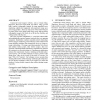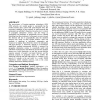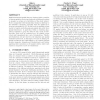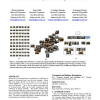112
click to vote
GIS
2008
ACM
15 years 3 months ago
2008
ACM
Information and specifically Web pages may be organized, indexed, searched, and navigated using various metadata aspects, such as keywords, categories (themes), and also space. Wh...
111
click to vote
GIS
2008
ACM
15 years 3 months ago
2008
ACM
Commercial aerial imagery websites, such as Google Maps, MapQuest, Microsoft Virtual Earth, and Yahoo! Maps, provide high- seamless orthographic imagery for many populated areas, ...
111
click to vote
GIS
2008
ACM
15 years 3 months ago
2008
ACM
In order to provide context?aware Location?Based Services, real location data of mobile users must be collected and analyzed by spatio?temporal data mining methods. However, the d...
116
click to vote
GIS
2008
ACM
15 years 3 months ago
2008
ACM
The pervasiveness of location-acquisition technologies (GPS, GSM networks, etc.) enable people to conveniently log the location histories they visited with spatio-temporal data. T...
113
click to vote
GIS
2008
ACM
15 years 3 months ago
2008
ACM
Multi-dimensional spatial data are obtained when a number of data acquisition devices are deployed at different locations to measure a certain set of attributes of the study subje...
108
click to vote
GIS
2007
ACM
15 years 3 months ago
2007
ACM
We present a novel framework for organizing large collections of images in a hierarchical way, based on scene semantics. Rather than score images directly, we use them to score th...
103
click to vote
GIS
2007
ACM
15 years 3 months ago
2007
ACM
We consider trails to be a document type of growing importance, authored in abundance as locative technologies become embedded in mobile devices carried by billions of humans. As ...
GIS
2007
ACM
15 years 3 months ago
2007
ACM
Many Geographic Information System (GIS) applications must handle large geospatial datasets stored in raster representation. Spatial joins over raster data are important queries i...
105
click to vote
GIS
2007
ACM
15 years 3 months ago
2007
ACM
This paper is committed to explore object-oriented methods for the classification of Quickbird images, aiming to support future urban population estimates. The study area concerns...
GIS
2007
ACM
15 years 3 months ago
2007
ACM




